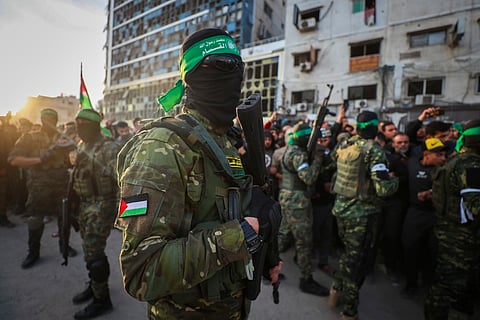Endless war, elusive victory: Qatar strike underscores limits of Israel’s bid to crush Hamas
Outrage over Doha strike grows as Hamas survives, casting doubt on Israel’s war aims

Dubai: Israel’s strike on Hamas leaders in Qatar this week was intended as a decisive blow in its nearly two-year war against the militant group.
Instead, it underscored the limits of a campaign that has failed to vanquish Hamas despite staggering destruction in Gaza and unprecedented measures abroad.
The attack, carried out as Hamas officials weighed a new ceasefire proposal in Doha, marked the first time Israel has bombed the Qatari capital.
Hamas claimed its top leaders survived, though it offered no proof. Israeli Prime Minister Benjamin Netanyahu hailed the strike as a warning and vowed to hit again unless Qatar expels Hamas officials. “You either expel them or bring them to justice — because if you don’t, we will,” he declared.
Qatar reacted furiously, calling the strike a “cowardly attack” on its sovereignty and accusing Netanyahu of “shameful” attempts to justify future violations. Doha stressed that its hosting of Hamas officials was at the request of Israel and the United States to facilitate mediation.
Endless war, elusive victory
Even if the strike killed senior Hamas leaders, analysts say it would not end the group. Hamas has survived assassinations before, and it retains fighters, weapons caches, and — crucially — around 20 hostages inside Gaza. Israel’s stated objective of not only defeating Hamas but ensuring it cannot reconstitute itself looks increasingly like a recipe for open-ended war and occupation.
Hamas leaders targeted abroad
Jordan, 1997 – Failed hit on Khaled Meshaal
Mossad agents tried to assassinate senior Hamas leader Khaled Meshaal in Amman by injecting poison. The attempt failed after Jordan’s King Hussein forced Israel to provide the antidote, saving Meshaal’s life.Dubai, 2010 – Mahmoud Al Mabhouh killed
Hamas military commander found dead in a Dubai hotel. The senior Hamas commander was murdered in his hotel room in Dubai on January 19.Damascus, 2004 – Syrian safe haven
Hamas co-founder Abdel Aziz Al Rantisi, though assassinated later in Gaza, frequently operated through Damascus, where Israel long accused Hamas of orchestrating attacks under Syrian protection.Tehran, 2024 – Hamas chief killed
Israeli assassinated Hamas political chief Ismail Haniyeh. Tehran condemned the incidents as “terrorism.”Lebanon/Malta, 1995 – Message through PIJ ally
Israel assassinated Fathi Shiqaqi, leader of Islamic Jihad, in Malta. While not Hamas, his close ties with the group showed Israel’s willingness to eliminate Palestinian militant leaders abroad.
Nearly all of Hamas’ Gaza leadership and thousands of militants have been killed. Its government has collapsed, its police force has largely vanished, and its rocket arsenal is depleted.
Yet Hamas has recruited new fighters during the war, and according to Israeli estimates, still commands thousands of militants capable of hit-and-run attacks. Around 50 Israeli soldiers have been killed in Gaza since March, including in roadside bombs and ambushes.
Costs at home and abroad
Israel now controls three-quarters of Gaza, much of it reduced to rubble. Local families and armed groups have filled the vacuum of governance. Public services barely function, with the UN and aid agencies providing most assistance. Tens of thousands of Palestinians are dead, famine grips Gaza City, and Israel’s reputation has sunk to new lows. Even Arab states that normalized relations with Israel now describe it as a regional menace.
The strike on Qatar has only deepened that perception, drawing condemnation across the Arab world and raising concerns it will derail efforts to reach a ceasefire. US and Egyptian officials warn that Israel’s refusal to compromise risks prolonging a cycle of destruction with no clear victory.
How Hamas emerged and grew in Gaza
Origins in the 1980s: Hamas was founded in 1987 during the First Intifada as the Palestinian offshoot of Egypt’s Muslim Brotherhood.
Early popularity: It gained traction by running charities, schools, and social services, which built grassroots support among Gaza’s poor and displaced.
Shift to militancy: By the 1990s, Hamas was carrying out suicide bombings and attacks against Israel, opposing the Oslo peace process led by the rival Fatah movement.
2006 election win: Hamas stunned the world by winning Palestinian legislative elections, capitalizing on anger at corruption in the Palestinian Authority.
2007 Gaza takeover: After a violent rift with Fatah, Hamas seized control of Gaza, ousting PA forces. Since then, it has been the enclave’s de facto ruler.
Consolidation through conflict: Repeated wars with Israel (2008, 2012, 2014, 2021, and 2023–25) hardened its military wing and boosted its reputation among Palestinians as the “resistance.”
Enduring appeal: Despite catastrophic losses in recent years, Hamas still commands loyalty from many Gazans who see it as the only force standing against Israeli occupation.
Hamas’ resilience
Hamas’ ideology and armed wing remain intact. Cells of militants, operating independently, continue to resist. Hostages are held under heavy guard, with fighters instructed to booby-trap their hideouts. Analysts warn that as long as Gaza’s population of 2 million sees Hamas as an option for governance, rival alternatives will fail to gain traction.
“Hamas has been degraded as an authority,” said one Gaza resident. “But it has not ended. It will exist as long as the occupation exists.”
For Netanyahu, the Qatar strike was meant to project strength. Instead, it may have highlighted the inescapable truth: After two years of war, Israel’s quest for “total victory” over Hamas remains as elusive as ever.
-- With inputs from AP
Sign up for the Daily Briefing
Get the latest news and updates straight to your inbox




